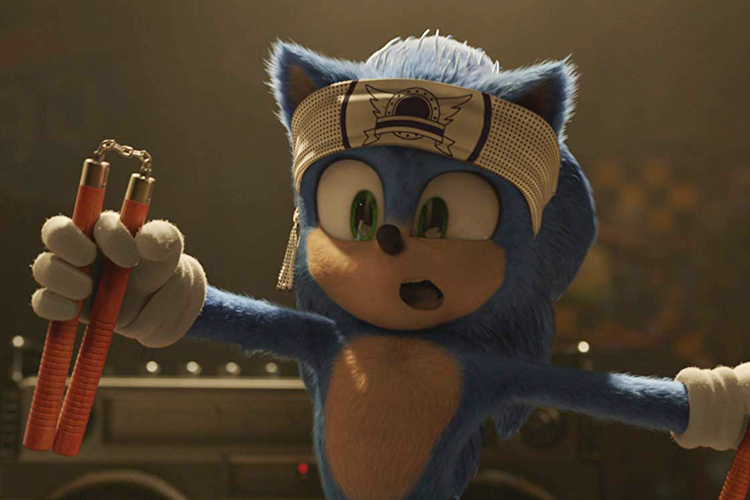In a way, the Sonic the Hedgehog video game franchise taught me how to be critical. I grew up playing the games and credit them for my interest in storytelling. But there’s a problem with the franchise: after 2001, most of the games are terrible. Not just badly made or disappointing—they’re misbegotten from the ground up, disasters in their very DNA. They taught me early on that liking something doesn’t make it worthwhile, which is an important step in learning to find and love better things. With that in mind, let’s talk about the Sonic the Hedgehog movie, shall we?
If you’re familiar with story of the games, you can keep that knowledge locked in the vaults of your nostalgia, because the movie lays down a completely different groundwork. Sonic is an anthropomorphic hedgehog who can run very fast (well, that’s the same) and hails from a different dimension. Apparently an orphan, Sonic was raised by an owl named Longclaw, who protects the hedgehog and warns him that others are jealous of his speedy powers. When one of these jealous parties tracks Sonic down, Longclaw sends him to Earth through a teleportation ring, and Sonic’s forced to spend his days in hiding.
In a matter of years, Sonic starts living the quintessential Earth life: lonely and purposeless. His only solace is spying on Tom Wachowski, a small-town cop who loves animals, movies, and his obsequious wife. When the government gets wind of Sonic’s power and sends a mad scientist to capture him, Sonic turns to Tom in his hour of need, forging an unlikely bond between a cop and an alien hedgehog. It’s a strange matchup given the source material—police are usually antagonists in the game franchise—but where the games’ hedgehog was rebellious and cocky, the movie’s is wholesome and wacky, so it fits the more juvenile tone the director is aiming for.
Like most Hollywood blockbusters, Sonic the Hedgehog follows the “hero’s journey” structure, which was popularized in the 50s and distilled into a step-by-step checklist by a Disney executive in 1992. The twelve-step structure can be summarized like this: protagonist goes about their ordinary life, something disrupts their ordinary life, protagonist reluctantly accepts the call to adventure, things go right and then go wrong, protagonist learns a lesson, an important object is obtained, things go really wrong and then really right, the end. The hero’s journey has been done to death—it’s the structure of nearly every superhero movie—but it’s reliable enough to turn low-effort storytelling into mindless escapism, if done correctly.
Sonic the Hedgehog does not do it correctly. The cracks in the story start to show immediately after its setup. The important object that Sonic loses and eventually needs to obtain is his bag of rings, which would allow him to teleport to a safer dimension at a moment’s notice. After a teleportation mishap, the rings end up on top of the Transamerica building in San Francisco, while Sonic and Tom are stuck in Montana. This should be the disruption that calls our protagonists to adventure, but minutes later, it’s established that Sonic can run from Montana to the Pacific Ocean in a matter of seconds—and that Sonic needs Tom to drive him to San Francisco because Sonic doesn’t know how to get there. Never mind the fact that it would take Sonic all of a minute to map out the continental United States. It’s hard to buy into the heroes’ journey if it feels entirely unnecessary.
The screenwriters fundamentally misunderstand the rules they’ve set for their own story. Cracks continue to stem from the artificial kneecapping of Sonic’s abilities, but it doesn’t stop there. The lesson that Sonic and Tom are supposed to learn is one of friendship, but their connection is held together only by Tom’s sense of duty and a fondness for cracking jokes, until the journey calls for a climax and they’re suddenly ride-or-die inseparable. Some of their wisecracks are worth a laugh—if a monkey hits a typewriter long enough, it’ll surely produce a few jokes—but most of the time, the movie’s humor is talking down to its younger audience: fart jokes, shameless product placement, woefully outdated cultural references and the like. The film’s screenwriters, Patrick Casey and Josh Miller, were behind the deliriously misogynistic college comedy series Dorm Daze—what did they do to earn a massive property like this? The whole affair reeks of a production team that just doesn’t care.
Should Sonic the Hedgehog be applauded for its infamous redesign of its title character? Non-mortifying effects work does not a good movie make. The only redeemable parts of this experience are Ben Schwartz, who voices Sonic, and Jim Carrey, who portrays the villainous Dr. Robotnik. Schwartz’s vocal performance is spirited and precocious; Carrey’s shtick is over the top to varying degrees of amusement. But these are band-aids on a wound that’s been festering for quite some time. Perhaps Sonic the Hedgehog is an accurate adaptation of the game—it’s misbegotten from the ground up, a disaster in its very DNA.
★ (1/5)




